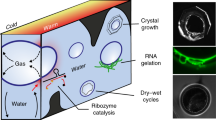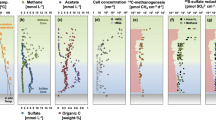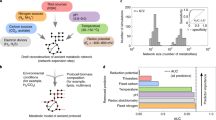Abstract
The upper temperature at which a living system can exist is limited by the hydrolytic breakdown rate of its chemical constituents. The peptide bonds of proteins, the phosphodiester and N-glycosyl bonds in RNA and DNA, and the pyrophosphate and N-glycosyl bonds in nucleotides such as ATP and NAD are among the more important bonds that will undergo hydrolysis. The decomposition of biomolecules via non-hydrolytic pathways such as decarboxylations and dehydrations may also be critical factors in determining this upper temperature limit. Baross and Deming1 recently reported ‘black smoker’ bacteria, which they isolated from deep-sea hydrothermal vents, growing at 250 °C. Here I have attempted to establish the rates for the hydrolysis and/or decomposition of critical biomolecules to determine their ability to exist at this temperature. My results clearly indicate that if these organisms exist, and if their metabolic reactions occur in an aqueous environment, they could not survive at this temperature if they were composed of biomolecules such as proteins and nucleic acids, due to the very rapid rate of decomposition of such molecules.
This is a preview of subscription content, access via your institution
Access options
Subscribe to this journal
Receive 51 print issues and online access
$199.00 per year
only $3.90 per issue
Buy this article
- Purchase on Springer Link
- Instant access to full article PDF
Prices may be subject to local taxes which are calculated during checkout
Similar content being viewed by others
References
Baross, J. A. & Deming, J. W. Nature 303, 423–426 (1983).
Brock, T. D. Thermophilic Microorganisms and Life at High Temperatures (Springer, New York, 1978).
Stitter, K. O. Nature 300, 258–260 (1982).
Abelson, P. H. Scient. Am. 195, 83–92 (1956).
Vallentyne, J. R. Geochim. cosmochim. Acta 28, 157–188 (1964).
Bada, J. L. & Miller, S. L. J. Am. chem. Soc. 92, 2774–2782 (1970).
Schultz, J., Allison, H. & Grice, M. Biochemistry 1, 694–698 (1962).
Weber, K. & Osborn, M. J. biol. Chem. 244, 4406–4412 (1969).
Steinberg, S. M. & Bada, J. L. J. org. Chem. 48, 2295–2298 (1983).
Bada, J. L. Adv. Chem. Ser. (No. 106), 309–331 (1971).
Liardon, R. & Hurrell, R. F. J. agric. Fd Chem. 31, 432–437 (1983).
Smith, G. G. & de Sol, B. S. Science 207, 765–767 (1980).
Steinberg, S. & Bada, J. L. Science 213, 544–545 (1981).
Brown, D. M. & Todd, A. R. J. chem. Soc. 1952, 52–58 (1952).
Lindahl, T. J. biol. Chem. 242, 1970–1973 (1967).
Eigner, J., Boedtker, H. & Michaels, G. Biochim. biophys. Acta 51, 165–168 (1961).
Tetas, M. & Lowenstein, J. M. Biochemistry 2, 350–357 (1963).
Sigel, H. & Amsler, P. E. J. Am. chem. Soc. 98, 7390–7400 (1976).
Ramirez, F., Marecek, J. F. & Szamosi, J. J. org. Chem. 45, 4748–4752 (1980).
Long, D. A., Truscott, T. G., Cronin, J. R. & Lee, R. G. Trans. Faraday Soc. 67, 1094–1103 (1971).
Keyes, F. G. in International Critical Tables Vol 3 (ed. Washburn, E. W.) 233 (McGraw-Hill, New York, 1928).
Gonikberg, M. G. Chemical Equilibria and Reaction Rates at High Pressures (National Science Foundation, Washington, DC, 1963).
Laidler, K. J. & Chen, D. Trans. Faraday. Soc. 54, 1026–1033 (1958).
David, H. G., Hamann, S. D. & Lake, S. J. Aust. J. Chem. 8, 285–288 (1955).
Williams, E. G., Perrin, M. W. & Gibson, R. O. Proc. R. Soc. A154, 684–703 (1936).
LeNoble, W. J., Srivastava, S., Breslow, R. & Trainor, G. J. Am. chem. Soc. 105, 2745–2748 (1983).
Fox, S. W. The Origins of Prebiological Systems and of Their Molecular Matrices (Academic, New York, 1965).
Trent, J. D., Chastain, R. A. & Yayanos, A. A. Nature 307, 737–740 (1984).
Bates, R. G., Pinching, G. D. & Smith, E. R. Bur. Stand. J. Res. 45, 418–429 (1950).
Stene, S. Recl. Trav. chim. Pays-Bas Belg. 49, 1133–1145 (1930).
Ramos, D. L. & Schoffstall, A. M. J. Chromatogr. 261, 83–93 (1983).
Sasaki, Y. & Hashizume, T. Analyt. Biochem. 16, 1–19 (1966).
Sweeley, C. C., Bentley, R., Makita, M. & Wells, W. W. J. Am. chem. Soc. 85, 2497–2507 (1963).
Hammerstedt, R. H. Analyt. Biochem. 52, 449–455 (1973).
Franke, W. W., Krien, S. & Brown, R. M. Jr Histochemie 19, 162–164 (1969).
Poolswat, S. S. Proc. EMSA 31, 364–365 (1973).
Watson, M. L. J. biophys. biochem. Cytol. 4, 475–478 (1958).
Venable, J. H. & Coggeshall, R. J. Cell Biol. 25, 407–408 (1965).
Author information
Authors and Affiliations
Rights and permissions
About this article
Cite this article
White, R. Hydrolytic stability of biomolecules at high temperatures and its implication for life at 250 °C. Nature 310, 430–432 (1984). https://doi.org/10.1038/310430a0
Received:
Accepted:
Issue Date:
DOI: https://doi.org/10.1038/310430a0
This article is cited by
-
Physical non-equilibria for prebiotic nucleic acid chemistry
Nature Reviews Physics (2023)
-
Prebiotic oligomerization and self-assembly of structurally diverse xenobiological monomers
Scientific Reports (2020)
-
The Abiotic Chemistry of Thiolated Acetate Derivatives and the Origin of Life
Scientific Reports (2016)
Comments
By submitting a comment you agree to abide by our Terms and Community Guidelines. If you find something abusive or that does not comply with our terms or guidelines please flag it as inappropriate.



